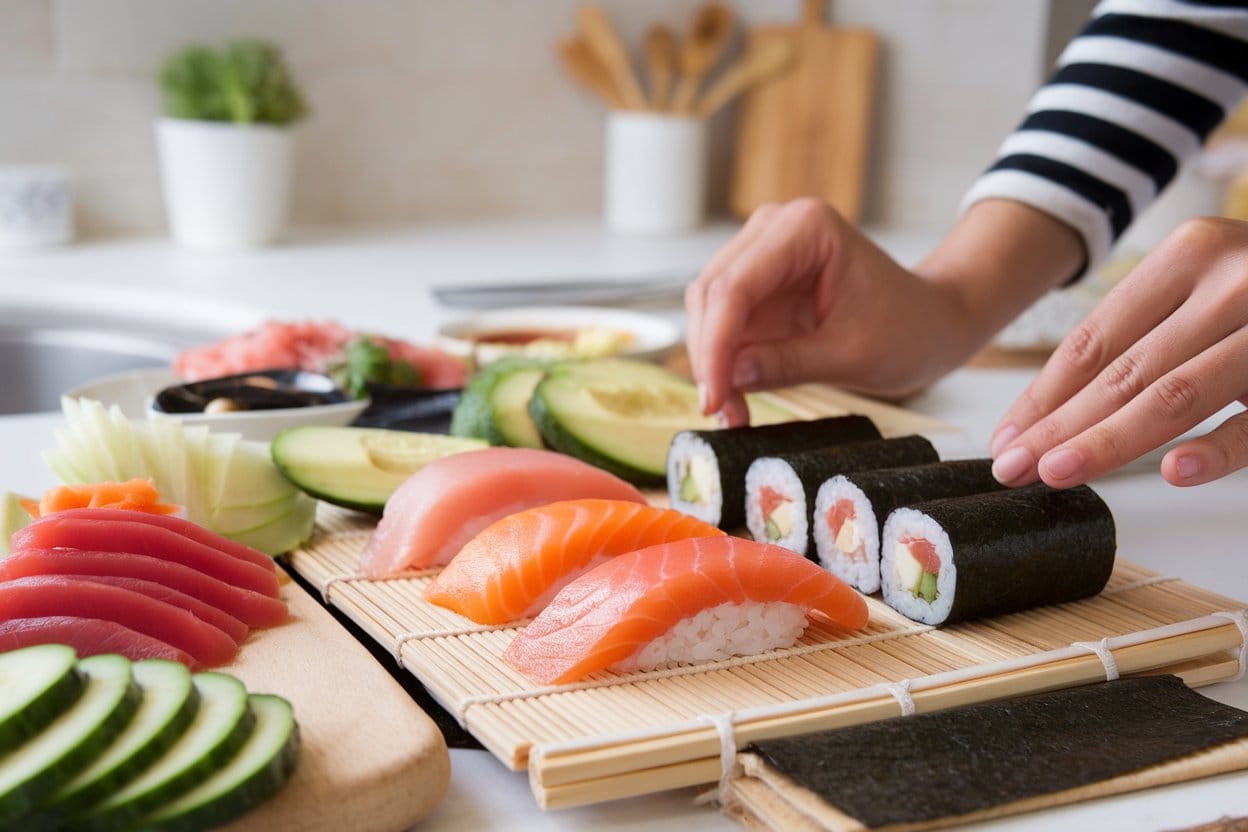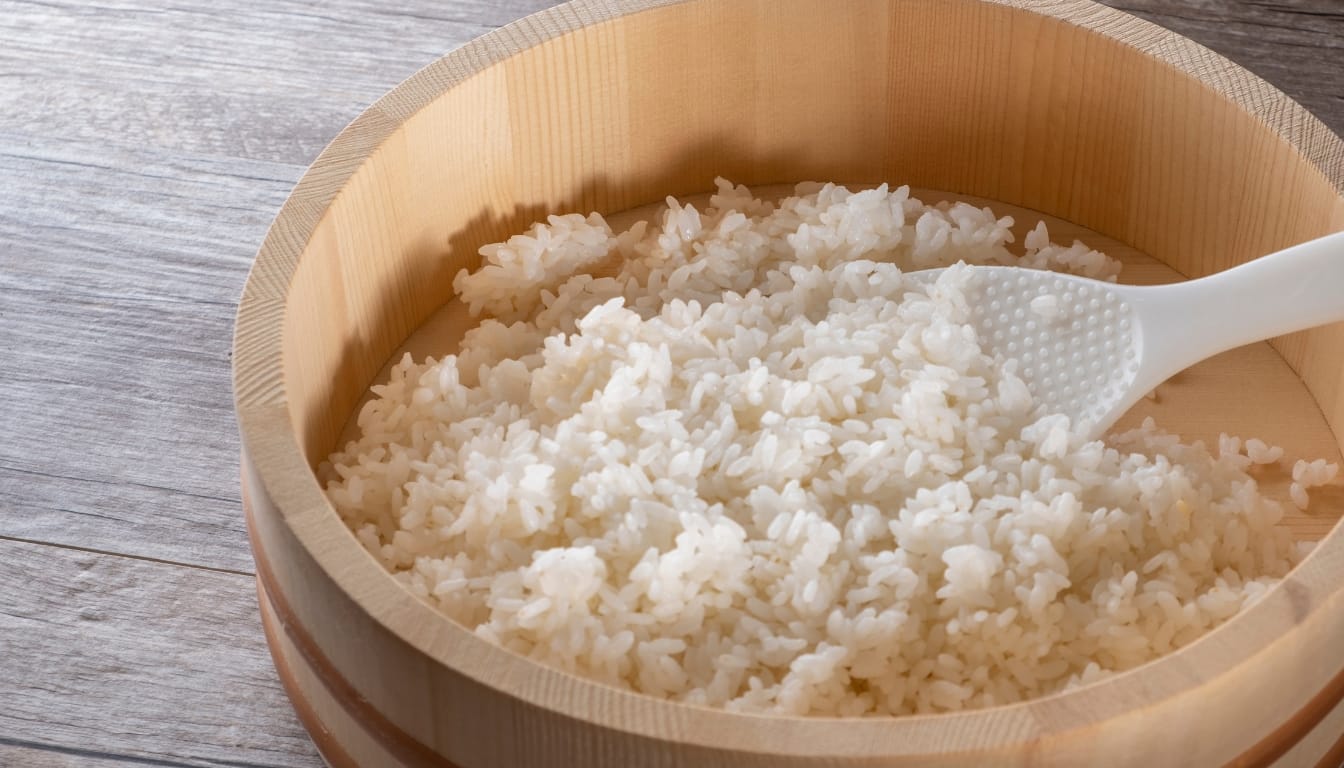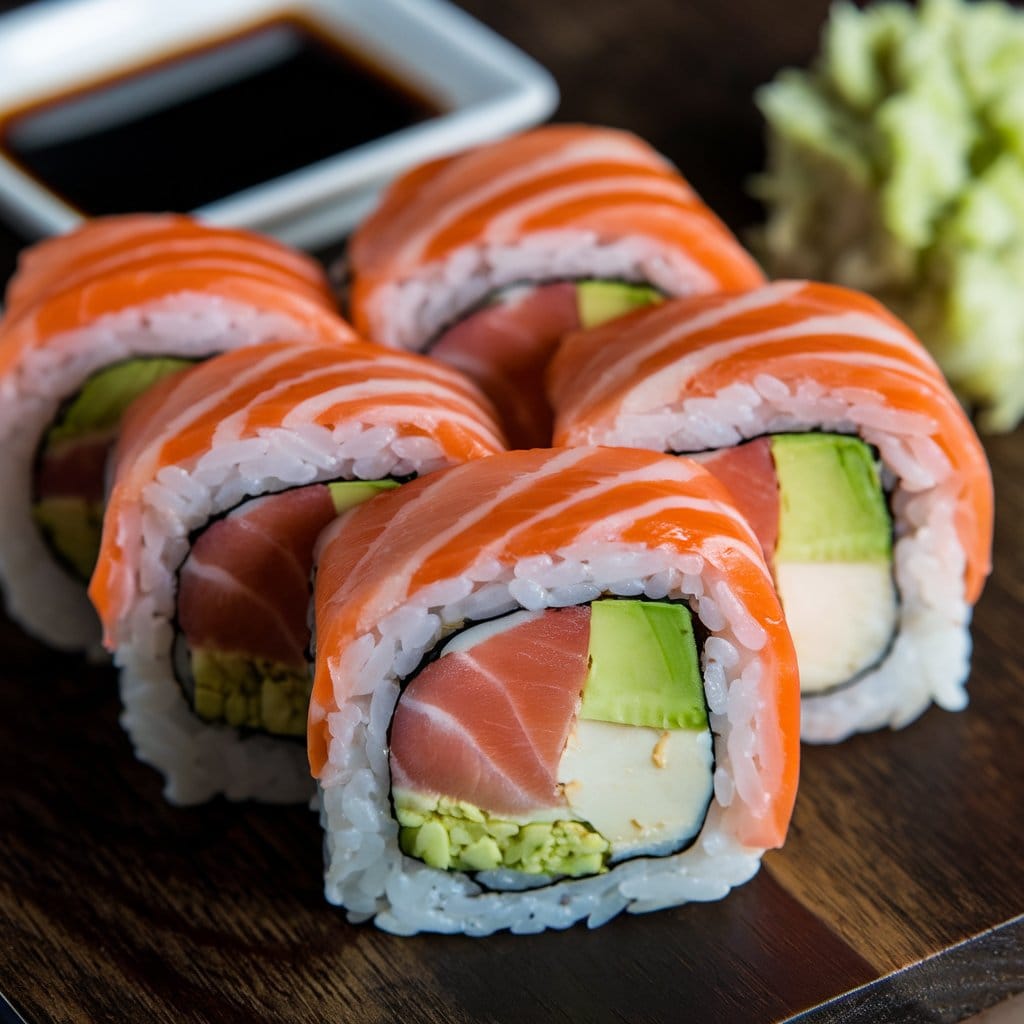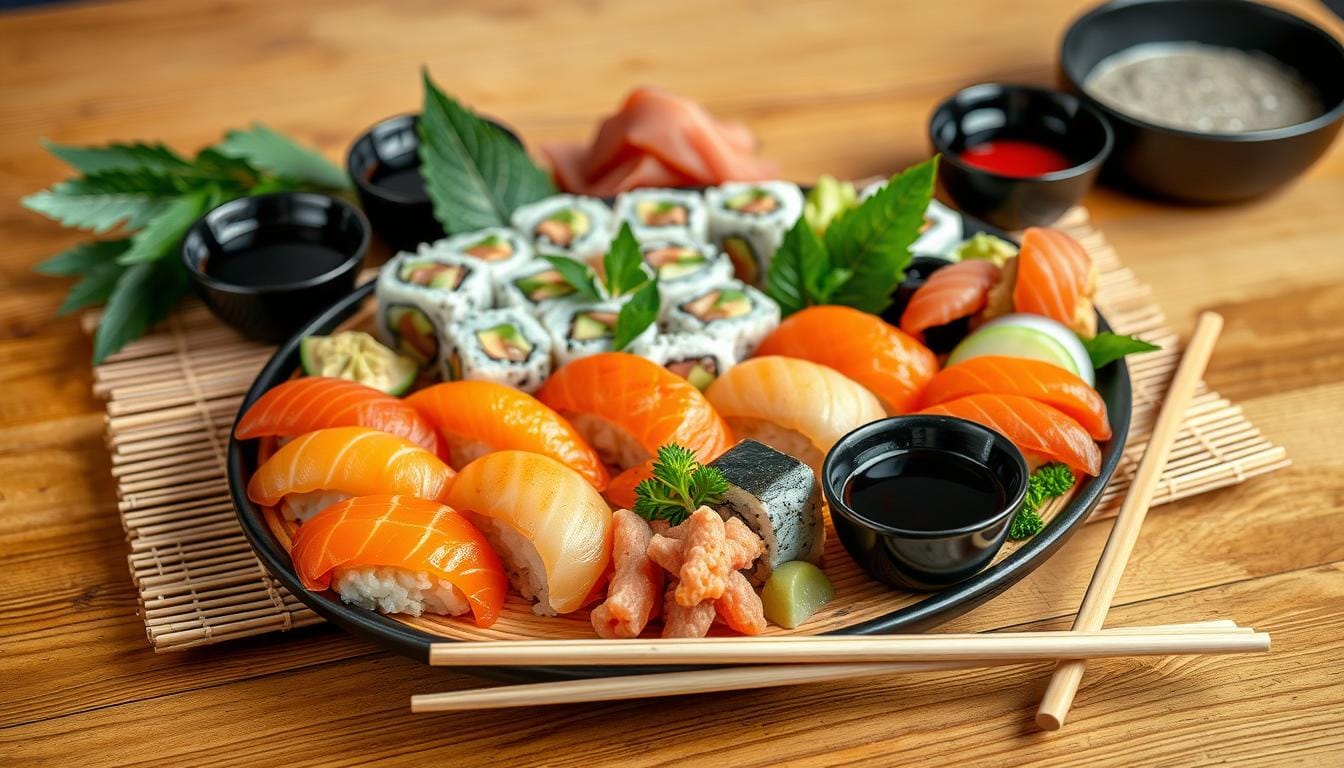Jump to Recipe
Putting together sushi at home is like magic. When I tried it for the first time, my kitchen turned into a little sushi bar, with the smell of vinegared rice and the bright colors of fresh ingredients. With a homemade sushi guide in hand, I took on the challenge and rolled my first maki rolls with some excitement and some fear.
At first, making sushi at home might seem hard, but it’s really fun and delicious. Every step is a thrilling adventure, whether you’re learning how to roll sushi or picking out the freshest fish and vegetables. It also lets you make your rolls exactly the way you like them.
This guide provides instructions on how to make sushi and offers do-it-yourself sushi adventures. The steps are simple and straightforward to follow. Get ready for a kitchen adventure in your apron.
Essential Ingredients for Homemade Sushi

To make tasty sushi at home, you need to know about the basics, like which brands of sushi rice are the best and how to find the freshest seafood. Let’s look at each important part to make sure your next sushi night goes well.
Sushi Rice
Picking the right sushi rice is essential for real results. Always choose well-known brands of sushi rice that are known for being good. Short- or medium-grain rice is best because it has the right amount of stickiness. I recommend brands like Nishiki and Tamanishiki because they consistently do a good job.
Nori Sheets
The type of nori you use affects both the taste and look of your sushi. When you shop for nori sheets, choose ones that are a deep green color and feel crisp. Products from brands like Yamamotoyama are reliable and won’t let you down.
Fresh Fish and Vegetables
It’s important to buy fresh sushi ingredients. Choose sashimi-grade cuts of fish and make sure they are fresh and full of flavor. A lot of people choose tuna, salmon, or yellowtail. Remember to add crisp vegetables like cucumber, avocado, and pickled radish to your food for more taste and texture.
Sauces and Condiments
The right sauces and toppings are an important part of any sushi meal. You should always have soy sauce, wasabi, and pickled ginger on hand. You can also make your sushi rolls better by adding a little spicy mayonnaise or eel sauce.
By paying attention to these sushi basics—from the brands of sushi rice to the quality of the nori—you can make sushi at home that tastes just as good as the sushi at your favorite restaurant.
Tools You Need for Sushi Making

You need certain sushi-making tools to get the best results. A bamboo sushi rolling mat and a sharp knife are two of the most important tools for making the perfect sushi roll.
Bamboo Rolling Mat
To make sushi rolls that are uniform and accurate, you need a bamboo sushi rolling mat. With this simple but useful tool, you can roll the nori sheets and fillings into tight, well-formed rolls. To be more flexible and in control, I suggest using a bamboo mat with thin slats.
When looking for a sushi rolling mat, SushiBazooka and BambooMN are excellent brands that last a long time and are simple to clean. Before you use your bamboo mat, make sure to wrap it in plastic wrap. This will keep the rice from sticking and make rolling easier.
Sharp Knife
When making sushi, you need a knife that is very sharp so that you can make clean cuts. The best sushi knives don’t have serrations, so you can perfectly slice your rolls, fish, and vegetables without them coming apart.
I think you should buy excellent knives, like those from Global or Shun, which are known for being sharp and lasting a long time. Your knife will stay in excellent shape if you take care of it regularly by honing it and storing it properly.
In addition to keeping your knife safe, keeping it in excellent shape makes making sushi a lot more fun.
Preparing Sushi Rice Perfectly

It’s important to learn how to make sushi rice before you can make the perfect sushi roll. Making sushi requires meticulous steps, particularly when handling the rice. Always follow these steps to make perfect sushi rice.
Rinsing the Rice
Rinsing the rice is one of the most important steps in making sushi rice. Put the amount of sushi rice you want to use in a bowl first. Put cold water in the bowl and stir the rice around with your hand. Do this a few times until the water runs clear, then drain it. This step is crucial for getting rid of extra starch, which helps make the texture just right.
Cooking and Seasoning
You must rinse the rice before cooking it. For precise sushi rice preparation, a rice cooker is best, but a pot with a lid that fits tightly will also work. One cup of sushi rice to 1.2 cups of water is how much water you should put into the rice cooker. Cooking the rice will make it soft. After it’s done cooking, let it sit for about 10 minutes before steaming.
Perfect sushi seasoning is what makes you taste the real essence of sushi. Mix rice vinegar, sugar, and salt together to make this. For every three cups of sushi rice, mix together two tablespoons of rice vinegar, two tablespoons of sugar, and one tablespoon of salt.
Be careful not to mash the grains as you fold this mixture into the cooked rice. Even with this seasoning, the rice will have the unique flavors that make sushi rice perfect.
How to Make Homemade Sushi Rolls

It might seem challenging to make your own sushi rolls at first, but it’s a fun and tasty activity. Let’s start with the basics of how to make sushi at home.
Start by putting your bamboo rolling mat on a clean, flat surface. Then, put a piece of paper towel on top of it. Setting it up like this keeps the rice from sticking to the mat and makes rolling easier. Lay a nori sheet on the mat, with the shiny side down.
Cover the nori with a thin layer of sushi rice. Leave about an inch of space on the rice’s top edge. Spread the rice evenly by gently pressing it down with the back of a spoon. This sushi technique is crucial for making perfectly rolled sushi.
Place strips of avocado, cucumber, and imitation crab meat along the bottom edge of the rice-covered nori to create a traditional California roll. On a tempura roll, you could put spicy mayonnaise and tempura shrimp. When you make your own maki, you can use any filling you want. For example, you could try smoked salmon, cream cheese, and fresh vegetables.
- Slowly lift the edge of the bamboo mat closest to you, then use your fingers to hold the fillings in place.
- Roll the mat slowly forward while pressing down gently but firmly to create a tight roll.
- Continue rolling the nori until the visible edge adheres to the roll. You can add a little water to the edge to help it seal.
After making the roll, cut it into small pieces with a sharp knife. To ensure that the slices are clean, wipe the knife down with a damp cloth in between cuts.
Place your sushi rolls on a plate and top them with pickled ginger. Serve with soy sauce and wasabi. Your homemade sushi, maki, and rolls will wow your friends and family, whether it’s a California roll, homemade maki, or tempura roll.
Conclusion
Learning how to make sushi at home is more than just a fun culinary experiment; it’s a chance to learn about the rich, complex traditions of Japanese food. From making the sushi rice with care to mastering the art of making a sushi roll, every step is a fun and creative experience that will make you feel positive about your kitchen.
As we’ve seen, the basics are simple to understand and very important. High-quality ingredients such as the best sushi rice, fresh fish, crisp vegetables, and umami-rich nori sheets form the base.
With the right tools, like a bamboo rolling mat and a sharp knife, you can get better at making sushi rolls and make sure that every bite has the right mix of tastes and textures.
Don’t forget that practice makes perfect. When you make sushi at home, you improve your skills and grow to love this carefully crafted art form more with each use. The real fun is trying out different tastes and styles until you find the ones that make your mouth water.
Prepare some sushi at home, invite some family or friends, and enjoy it with a lot of energy. You should try this cooking adventure. With each roll, you’ll get better and more passionate about cooking.

Homemade Sushi Rolls
Ingredients
Method
- Prepare the Sushi Rice:
- Rinse 2 cups of sushi rice in cold water until the water runs clear. Cook with 2.5 cups of water in a rice cooker or on the stove. Let it rest for 10 minutes after cooking.
- Season the Rice:
- Mix 1/4 cup rice vinegar, 2 tbsp sugar, and 1 tbsp salt. Fold this mixture into the cooked rice without smashing the grains. Let it cool.
- Prepare Ingredients:
- Slice your sashimi-grade fish into thin strips. Julienne the cucumber, slice the avocado, and set aside the nori sheets.
- Set Up Rolling Station:
- Lay the bamboo mat flat and place a sheet of nori, shiny side down. Wet your hands and spread a thin layer of rice evenly over the nori, leaving about 1 inch at the top.
- Add Fillings:
- Arrange the fish, cucumber, and avocado along the bottom edge of the rice-covered nori.
- Roll the Sushi:
- Slowly lift the bamboo mat and roll the sushi, pressing gently but firmly to keep the roll tight. Seal the edge of the nori with a bit of water.
- Slice and Serve:
- Use a sharp knife to cut the sushi roll into bite-sized pieces. Wipe the knife with a damp cloth between cuts to ensure clean slices.
- Serve:
- Place sushi on a plate and serve with soy sauce, wasabi, and pickled ginger.
Notes
- Use a sharp knife for clean sushi slices.
- Keep a bowl of water nearby to dip your hands in when spreading rice to avoid it sticking.
- Try adding other fillings like tempura shrimp or smoked salmon for variety.
- Don't worry if your first rolls aren't perfect—practice makes perfect!

